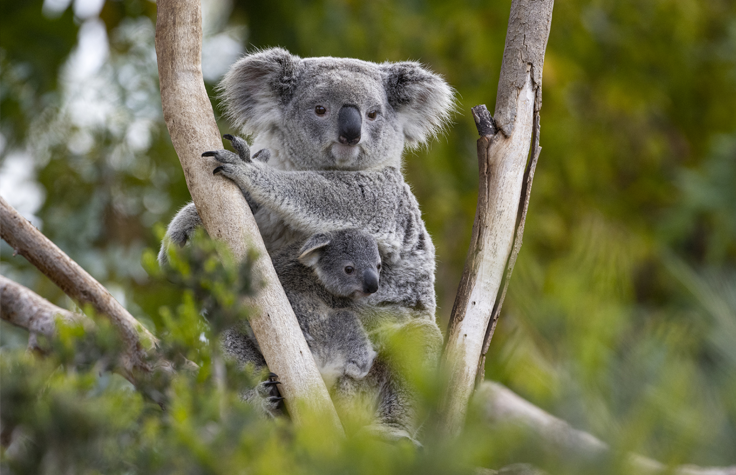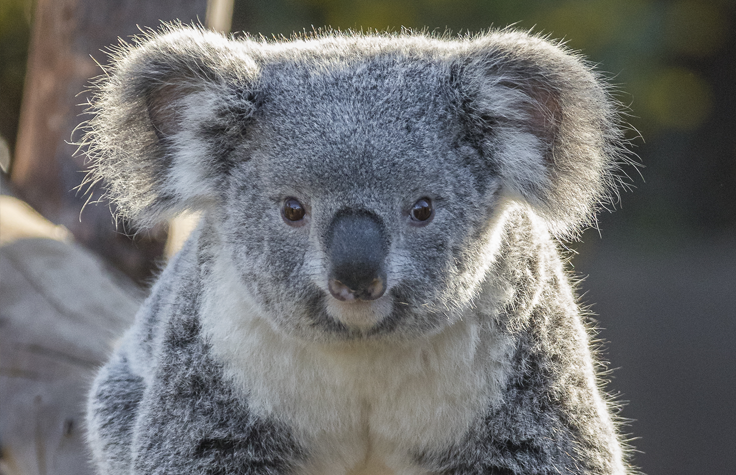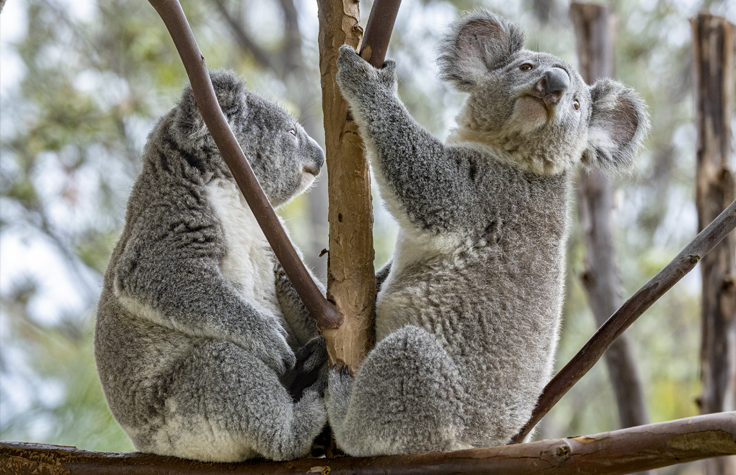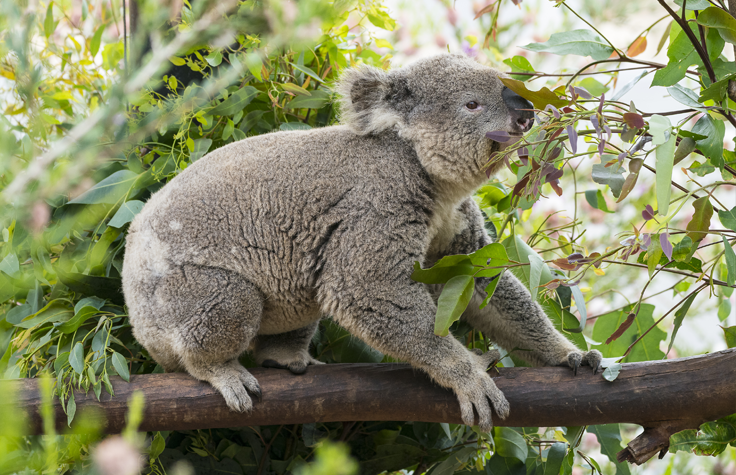
9 January 2024
The San Diego Zoo cares for the largest population of koalas outside Australia. The zoo is world renowned for its specialized veterinary care and decades-long commitment to wildlife conservation work, and one of the biggest challenges their koala population faces is koala retrovirus (KoRV). This virus is associated with numerous fatal conditions—susceptibility to bacterial infections, leukemia, lymphoma, and other cancers—and 100% of koalas in North America carry it. Research shows that 100% of wild koalas in the Australian states of Queensland and New South Wales have it, and between 15% and 70% in Victoria have it, too. How is this possible?
Everyone is part virus
Viruses that are transmitted horizontally—that is, through infection—are exogenous. These are the kind we’re most familiar with. They inject their genetic code into an organism’s somatic (nonreproductive) cells, tricking them into making copies of the virus, which can then go on to infect other organisms.
However, some viruses hit the proverbial motherlode and inject their genetic code into an organism’s germline (reproductive) cells—the sperm or eggs. Once this happens, the viral DNA can become a permanent part of their host’s genome: an endogenous virus, transmitted not horizontally but vertically, from one generation to the next.
It sounds alarming, but it’s commonplace. All living organisms have accumulated retroviral DNA as part of their own. The remains of endogenous retroviruses constitute up to eight percent of the human genome. But in most species, these viral integrations transpired millions of years ago, and the DNA has degraded to the point where it can no longer infect other hosts nor cause health problems. (A virus that killed its host and also couldn’t transmit outside the body would quickly be eliminated by natural selection.)
“We don’t know what happens to the host between the time a retrovirus is exogenous and when it becomes a relatively harmless hitchhiker,” says Alex Greenwood, head of the Department of Wildlife Diseases at the Leibniz Institute for Zoo and Wildlife Research. “We also do not know how the virus changes, if at all, during this time to better adapt to the host.”
Rachael Tarlinton, associate professor of Veterinary Cellular Microbiology at the University of Nottingham, adds that “in some cases these viruses are also beneficial for their hosts, changing gene expression and introducing new genetic diversity. We just don’t know how this process happens, or how quickly the changes to host and virus take to settle down.”

Koalas at risk
KoRV is a different case. It only started endogenizing within the last 50,000 years—on an evolutionary timescale, that’s practically yesterday—so some of its subtypes are still exogenous, and none of its sharp edges have yet been sanded down, so to speak.
KoRV subtype A is endogenous: That’s the kind that 100% of the San Diego Zoo’s koalas and most wild koalas have. But subtypes B, C, and so on are still exogenous, and all subtypes are associated with serious health problems. A few years ago, the zoo briefly detected exogenous subtypes in its koalas using PCR tests, and they were able to change their care and breeding practices to keep these subtypes from spreading.
It helps that koalas are naturally solitary and sleep up to 20 hours a day—they don’t breed freely in large social groups like some animals do. Instead, the zoo’s wildlife care specialists manage their genetic diversity using careful records of mean kinship, which keep track of how closely the animals are related. For each female, they maintain a list of the most suitable males, and introduce them to her one at a time until she accepts one to mate with.
A female koala becomes sexually mature at two years old and typically lives 12 to 14 years. In that time she can have eight to 10 babies (called “joeys”), but among wild koalas, chlamydia is a widespread and pernicious cause of infertility. Thankfully, it’s easily detectable, and the zoo’s careful breeding management keeps their population free of it.
However, all koalas remain at high risk for cancer. Cora Singleton, senior veterinarian for the San Diego Zoo Wildlife Alliance, describes its occurrence as sudden and heartbreaking: “Koalas are very good at hiding early stages of some cancers. They may appear normal one day, then show a subtle behavior change the next day. We check the blood and bone marrow and find that they have late-stage cancer, which progresses rapidly.” Sadly, there’s no known treatment for the koalas at that point.
KoRV is associated with these health issues and widely hypothesized to be what’s causing them, but more genomic research is needed to bridge that gap. “It’s difficult to prove that causative link,” says Damien Higgins, professor of wildlife health and pathobiology at the University of Sydney. “We see a whole range of conditions in koalas that often occur with immune suppression or dysfunction, and we see association of higher levels of koala retrovirus in those animals, but it’s a bit of a chicken-or-egg situation.”

The iConserve koala retrovirus sequencing project
In 2021, Greenwood, Tarlinton, Singleton, Higgins, and David Alquezar, manager of the Australian Centre for Wildlife Genomics at the Australian Museum, hosted the Second Koala Retrovirus Workshop to facilitate multidisciplinary discussions about KoRV and koala management.
One of that workshop’s ultimate recommendations recognized a need for longitudinal studies, across multiple generations, to investigate the genetic causation of these health conditions—and in 2023, Singleton contacted iConserve, a community program at Illumina, to begin just such a study with the cooperation of her workshop colleagues.
The San Diego Zoo preserves genetic samples of most koalas in their care, including many from former generations dating all the way back to the current population’s founders in the 1970s—and Illumina performed whole-genome sequencing on all of them. This data, spanning five generations, was uniquely valuable. “It’s a closed system whose pedigree we understand, which would not be possible from a population in the wild,” Alquezar explains. “It’s a longitudinal study that’s really relevant in this particular case. We’ve never had this type of information before.” Ultimately, the project will represent the largest pedigree of any koala genomic database to date.
The study will compare the known causes of death in the zoo’s pedigree with any KoRV integration patterns revealed in the sequencing data, to see how strongly particular integration sites associate with negative health outcomes. For example, Singleton explains, “If we see that specific KoRV integration patterns are associated with certain cancers in koalas from the past, we may be able to predict which koalas in the future will be at higher risk of developing these cancers.” Information like this would be critical to take into account when, for example, the wildlife care specialists plan which pairs would be best for breeding.
This knowledge will also inform management decisions for koalas in the wild. The marsupials’ natural habitat range has drastically fragmented in recent years, due in part to the terrible bushfires that struck Australia in 2019 and 2020. Disconnected populations lead to lower genetic diversity and lower resistance to disease. Conservation workers can translocate specific animals from one group to another to increase genetic diversity, and can avoid introducing a new subtype of KoRV to a population where it didn’t previously exist.
Discovering whether retroviral integration sites are associated with immunological genes would be a huge boon to research. “There are very few examples of such a virus that is currently endogenizing,” Alquezar says. “So for us to be able to understand those mechanisms of endogenization, how it might actually cause disease, is very interesting. We’re able to decipher that using this particular model. This has implications on koala health and may be an important factor in their conservation.”

To intervene or not to intervene
Considering how ubiquitous retroviral DNA is in animal genomes, the scientific community has raised the question of whether humans should intervene at all in the slow and likely inevitable process of KoRV endogenization. But those involved in this iConserve study recognize our collective responsibility in this case.
“Yes, it is a natural process,” Higgins says, “but it’s going on in an unnatural environment and context that humans are causing. It’s up to us to create an environment where that natural process can unfold. From an evolutionary perspective, it’s hard to adapt to something if you’ve got all these other pressures. We’re identifying which populations are most at risk and focusing on removing other risks to allow them to cope.”
Singleton agrees. “Over time, we expect the koala to adapt to this endogenizing virus. Until this happens, koalas are threatened by KoRV as well as by habitat loss and fragmentation. We can’t eliminate KoRV from koalas, but we can preserve and protect the healthy ecosystems that they need to survive.”
As of this writing, the sequencing phase of the project is complete, and Guilherme Neumann, a postdoctoral bioinformatician at the Leibniz Institute, has already identified over 1500 KoRV insertions across the 91 animals sequenced. As expected for a relatively small zoo population, these koalas generally share more KoRV integration sites than their wild counterparts do. “The interesting part now,” Greenwood says, “will be to see if the shared integrations are generally in parts of the genome where they do less harm—and if so, to focus on the ones that are less widely shared, which may contain the more problematic KoRV integrations. Those might end up being targets for potential management.”
In the meantime, Singleton is optimistic that this research could be a turning point for koala conservation. “We’ve known for many years that we have something really special in the data from the North American koala population, but we haven’t been able to access the technology to analyze it,” she says. “Through our partnership with Illumina, we are achieving research objectives that seemed unreachable back in 2021. Bringing together this international team, learning from our koala population to help koalas in their native range, is a career pinnacle for me as a zoo veterinarian.”
The problem with being a picky eater
Koalas eat only eucalyptus, a leaf that’s toxic to other animals. They’ve evolved special metabolic and gut microbiome adaptations specifically for digesting it, giving them exclusive access to a food that other species have learned to avoid. Ironically, this may be one reason it’s so difficult to treat some diseases in koalas. “In order to eat eucalyptus, the koala is very good at degrading plant toxins,” Singleton says. “Similarly, koalas are able to degrade many medications to the point that they become ineffective.”


